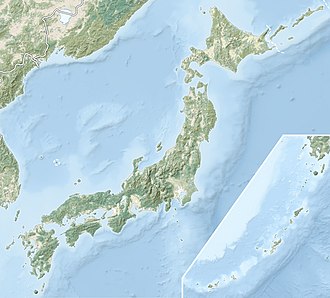Top Qs
Timeline
Chat
Perspective
Tamaudun
Former mausoleum of the Ryukyu Kingdom From Wikipedia, the free encyclopedia
Remove ads
Tamaudun (玉陵, Okinawan:Tamaudun) is one of the three royal mausoleums of the Second Shō Dynasty of kings of the Ryukyu Kingdom, along with Urasoe yōdore at Urasoe Castle and Izena Tamaudun near Izena Castle in Izena, Okinawa. The mausoleum is located in Shuri, Okinawa, and was built in 1501[1] by King Shō Shin, the third king (reigned 1477–1527), to bury his father, King Shō En a short distance from Shuri Castle. The Tamaudun complex was designated a National Historic Site in 1972. [2] It was designated a World Heritage Site by UNESCO on December 2, 2000, as a part of the site group Gusuku Sites and Related Properties of the Kingdom of Ryukyu and a National Treasure in 2018.[3][4]
Remove ads
Overview
Summarize
Perspective
The Tamaudun site, covering an area of 2,442 m2,[3] consists of two stone-walled enclosures, the three compartments of the mausoleum itself facing north and backed by a natural cliff to the south.[5] A stone stele in the outer enclosure memorializes the construction of the mausoleum, which was finished in 1501, and lists the name of Shō Shin along with those of eight others involved in the construction.[3] The three compartments of the mausoleum are laid out from east to west, with kings and queens in the eastern compartment and the princes and rest of the royal family in the western compartment, the central compartment used for the Ryukyuan tradition of senkotsu;[3][5] remains would only be kept here for a limited time to allow for decomposition, after which the bones were washed and placed in urns. The remains of the king and his queen were placed in the east chamber, while those of the other royal family members were placed in the west chamber.[6]The exterior of the structure is separated into an outer garden and a courtyard by a stone wall, and the courtyard is paved with coral fragments. The shisa (stone lions) guarding the tomb are examples of traditional Ryūkyūan stone sculpture. The architectural style of the mausoleum represents that of the royal palace at the time, which was a stone structure with a wooden roof.[3][6]
The structure suffered extensive damage in the 1945 Battle of Okinawa, as it was located near the Japanese Supreme Commander's office, was caught in the crossfire of concentrated artillery fire along with Shuri Castle, suffering extensive damage, including the destruction of the east and west chambers. The ruins were subsequently looted,[1] but the tombs and royal remains themselves remained intact, and much of the structure has since been restored. In 1992 Hiroshi Shō, the great-grandson of Shō Tai, the last king of the Ryūkyū Kingdom, donated Tamaudun and the royal gardens of Shikina-en to the City of Naha.
Remove ads
Burials
Summarize
Perspective
Seventeen of the 19 kings of the Second Shō Dynasty who ruled between 1470 and 1879 are entombed at Tamaudun, along with various queens and royal children. The first person to be buried there was Shō En, for whom the mausoleum was constructed upon the orders of his son and successor, Shō Shin. However, for approximately 25 years, Shō En was not initially interred here, given that he died in 1476 and the mausoleum was not completed until 1501. Other monarchs not interred here include Shō Sen'i (1430–1477), who was not later re-interred here as his brother was, and Shō Nei (1564–1620) who chose to be interred separately in Urasoe yōdore in the aftermath of the Invasion of Ryukyu. The last interree was former Prince of Nakagusuku, Shō Ten, the son of the Ryūkyū Kingdom's last king, Shō Tai, who was entombed there in 1920 in accordance with traditional Ryūkyūan royal funerary rites, followed by his wife Shōko, Nodake Aji-ganashi, in 1931.
|
|
Remove ads
Gallery
See also
References
External links
Wikiwand - on
Seamless Wikipedia browsing. On steroids.
Remove ads














